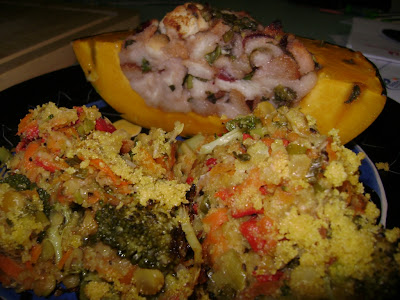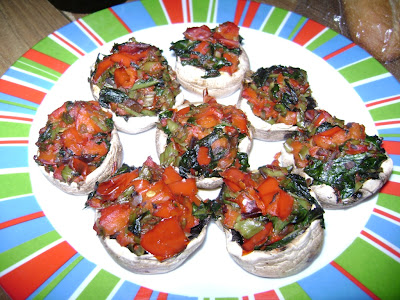Yesterday was a big deal for Australia. Kevin Rudd, the new prime minister, made a formal apology to the Stolen Generations on behalf of the Parliament. The 7.30 Report offered really good pre- and post-apology coverage which is worth a watch. This was a big step, but yet, a lot of people are still sadly misinformed about what, exactly, he was apologising for. Even fewer non-Australians have any clue what the Stolen Generations is. If you’re curious, check out this site, or read Kevin Rudd’s speech here. As a researcher studying Aboriginal activism, I had to go to all the celebrations around Townsville (in the name of duty, afterall) and was regaled by dancing and speeches. I’m glad I was in Australia to see this bit of history unfold.
On the theme of Indigenous Australians, I wrote a short article at the end of January which I'm thinking of submitting to
Vegan Voice, Australia's premiere (only?) vegan periodical. Before I send it off, though, I'd like to get some feedback about it. So if you're interested, have a read through and let me know what you think--does it make sense, can you follow the argument, should I expand on anything, that sort of thing. I've tried to keep it short, because there are a whole lot of examples that could be brought in, but here it is...
Getting rid of the cages On Saturday, 26 January, 2008 an Aboriginal father of five was arrested for drink driving. Since he was serving a suspended sentence for an earlier driving offence, he was remanded to the nearest jail—over 900 km away. He was driven in the back of a paddy wagon which has been described as ‘in a parlous state’, with air conditioning that was very likely not working. During that trip, he collapsed and later died in hospital. The cause of death was a heart attack, and with daytime temperatures of 43 degrees it is hard to believe that transport conditions played no part in the death.
This Aboriginal man’s journey sounded strikingly similar to the transport of farm animals. A Canadian animal rights group reports that over 600 million Canadian farm animals are loaded into the backs of semi-trailers and transported for hours on end in the heat of summer and the cold of winter, with no concern for their health and welfare. The Animal Freedom Foundation reports that pigs are transported to slaughterhouses in violent and stressful conditions; and laying hens are “pushed violently into crates for transport, risking fracture, and transported to the slaughterhouse in trucks under stressful conditions”. The Fremantle group, People Against Cruelty in Animal Transport (PACAT) calls for an end to live animal exports from Australia because of stress, injuries, illness and disease which leads to the death of tens of thousands of sheep, cattle, buffalo, goats, deer and camels every year.
Stressful, unnecessary transportation in hot conditions leads not only to the death of animals, but also Ian Ward, the Aboriginal elder from Warburton.
This isn’t the only case of Australia’s Aboriginal population being treated like animals. Any history book (or current events, it seems) will indicate a similar disregard for both black people and animals. For example, a 16 year old boy was killed while in police custody in the 1980s; witnesses saw four police officers and one police aid hitting the boy and then they dragged him to a van and ‘threw him in like a dead kangaroo’. No wonder average police officers think of Aboriginal people as animals; the Sydney District Police Commander, Executive Chief Superintendent Alf Peate, in 1990, was quoted: ‘normal surveillance activities can’t operate in a place like the black community . . . Where do you survey the activity of people when they are all the one breed’?
This type of treatment is well represented since the start of colonisation. Monaghan describes some disturbing evidence of trade in Aboriginal body parts:
A deathbed memoir written by Korah H Wills—gold-rush immigrant who became mayor of Bowen in Queensland and a candidate for the colonial parliament—found five years ago in a Surrey attic, contains a confession about the killing of an Aborigine who was later dissected for display.
Evans et al. provide observations made in 1871 that clearly indicates the utter lack of disregard for Aboriginal life:
Another occasion, I was travelling on a road where for more than a quarter of a mile, the air was tainted with the putrefaction of corpses, which lay all along the ridges, just as they had fallen. It is true that the offence here was the murder of five shepherds, on one station, in a week, but such wholesale and indiscriminate vengeance seems rather disproportionate, to say the least.
This is just one example of large-scale massacres held all over Australia in the first century of white invasion. The imagery is reminiscent of descriptions of rotting bison carcasses in the plains states of the United States during the 19th century, where bison were left to decay until the bones could be collected easily. It is common to read of Aboriginal people being shuttled to reserves on cattle trucks, or having their food and water sources poisoned—much like poisoned food left out for stray cats.
Point out these connections to Aboriginal people, and they’re not surprised. As Rintoul bluntly states in his recollections of the past, “That’s the kind of thing Aboriginals had to put up with. They treated us like animals”. When I sat in the Human Battery Cage in Townsville last July, an Aboriginal friend came up and expressed his support, saying he feels for the chickens: ‘they live their whole lives in confinement, just like us blackfellas.’ He said we need to get rid of all the cages in the world, whether they are imprisoning animals, black people, or women.
It’s easy for vegans to become complacent; we think that we’re doing all we can simply by changing our consumption habits. It’s also easy to view problems like racism and speciesism in isolation (and sexism, classism, etc). But the issues are inextricably linked. The blatant disregard for the life and well-being of animals is mirrored in the structural injustices experienced by Aboriginal people in Australia. Ethical vegans need to be aware of these other injustices.
As Lorna Lippman says, “The whole Australian community is at fault for allowing monstrous injustice towards a small minority to continue for so long without stern measures for its amelioration”. In my opinion, this statement can be applied to any number of injustices. Since ethical vegans are already aware of these injustices towards animals, we are ideally seated to bring attention to other injustices in the community and work towards the amelioration of all of them. How do we do it? Join email lists like Women for Wik or WGAR to keep up to date on national happenings. Most importantly, ask around in your local community; there is sure to be an Indigenous action group of some kind. Go to a meeting, or if that makes you uncomfortable, go to an event like Sorry Day or NAIDOC Day. Bring vegan treats to share. Listen to their problems and offer them support in any way you can.
Because really, if society can’t treat fellow human beings with respect and compassion, can we really expect compassion to animals?
__________
[1] http://www.news.com.au/story/0,23599,23134420-421,00.html
[2] http://news.theage.com.au/wa-prisoner-transport-fleet-parlous/20080131-1pbv.html
[3] http://www.news.com.au/story/0,23599,23123722-2,00.html
[4] http://www.theage.com.au/news/national/police-under-scrutiny-after-
aboriginal-custody-death/2008/02/01/1201801035358.html
[5] http://www.spca.bc.ca/farminfo/transportation/
[6] http://www.animalfreedom.org/english/information/5rights.html
[7] http://www.pacat.org/facts.htm
[8] Lippman, L. (1991), Generations of Resistance, Melbourne: Longman Cheshire, p. 105.
[9] Lippman, L. (1991), Generations of Resistance, Melbourne: Longman Cheshire, p. 117.
[10] Monaghan, D. (1991), “Angel of Black Death”, The Bulletin, 12 November, pp. 31-8.
[11] Evans, R., Suanders, K. and Cronin, K. (1979), “G Carrington 1871”, in Beyond the Act. Queensland Aborigines and Islanders: What do we want?, L. Malerzer, M. Foley and P. Richards, Foundation for Aboriginal and Islander Research Action Ltd, Brisbane.
[12] "Cherokee Outlet Cowboy--Recollections of Laban S. Records" by Laban Records b. 1856, d. 1941
[13] Reynolds, H. (1989), Dispossession: Black Australians and White Invaders, St Leonards, NSW: Allen and Unwin.
[14] Reynolds, H. (1989), Dispossession: Black Australians and White Invaders, St Leonards, NSW: Allen and Unwin.
[15] http://www.abc.net.au/science/news/stories/s1429383.htm
[16] Rintoul, S. (1993), The Wailing: A National Black History, William Heinemann, Victoria.
[17] Lippman, L. (1991), Generations of Resistance, Melbourne: Longman Cheshire, p. 132.
[18] http://www.nwjc.org.au/womenforwik.html
[19] wgar.news@gmail.com

















































